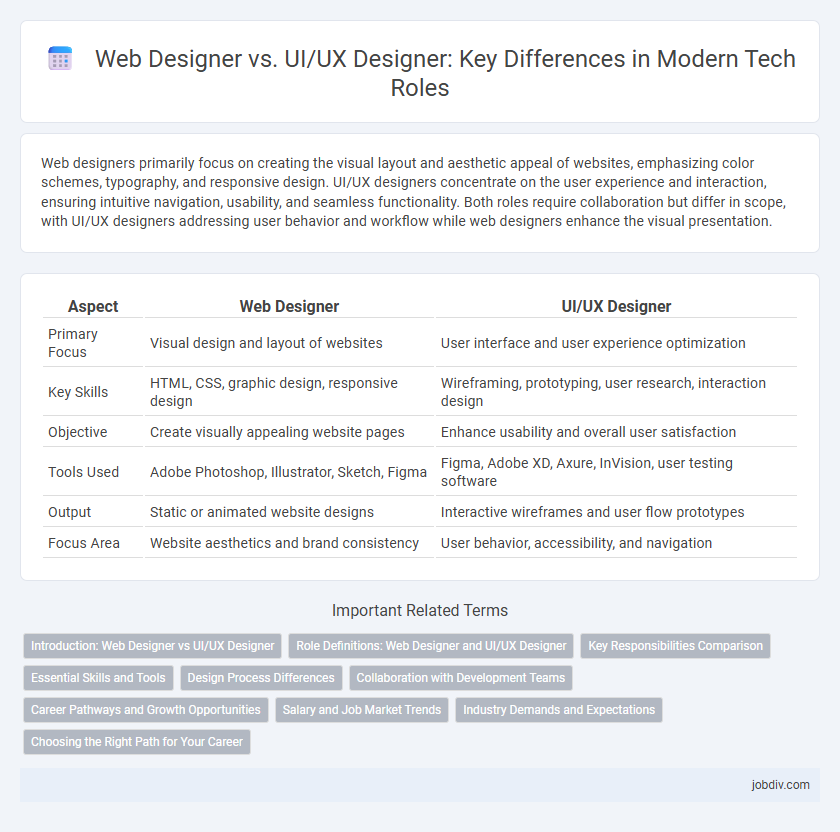Web designers primarily focus on creating the visual layout and aesthetic appeal of websites, emphasizing color schemes, typography, and responsive design. UI/UX designers concentrate on the user experience and interaction, ensuring intuitive navigation, usability, and seamless functionality. Both roles require collaboration but differ in scope, with UI/UX designers addressing user behavior and workflow while web designers enhance the visual presentation.
Table of Comparison
| Aspect | Web Designer | UI/UX Designer |
|---|---|---|
| Primary Focus | Visual design and layout of websites | User interface and user experience optimization |
| Key Skills | HTML, CSS, graphic design, responsive design | Wireframing, prototyping, user research, interaction design |
| Objective | Create visually appealing website pages | Enhance usability and overall user satisfaction |
| Tools Used | Adobe Photoshop, Illustrator, Sketch, Figma | Figma, Adobe XD, Axure, InVision, user testing software |
| Output | Static or animated website designs | Interactive wireframes and user flow prototypes |
| Focus Area | Website aesthetics and brand consistency | User behavior, accessibility, and navigation |
Introduction: Web Designer vs UI/UX Designer
Web Designers specialize in creating visually appealing and functional website layouts using tools like Adobe Photoshop and HTML/CSS, focusing on aesthetics and user navigation. UI/UX Designers emphasize user experience and interface design, employing user research, wireframing, and prototyping to optimize interaction and usability. Both roles require collaboration but differ in scope, with Web Designers targeting site structure and graphics while UI/UX Designers prioritize user-centered design principles.
Role Definitions: Web Designer and UI/UX Designer
Web Designers primarily focus on the visual layout, graphics, and overall aesthetic appeal of websites, ensuring that designs are responsive and visually engaging across devices. UI/UX Designers concentrate on enhancing user interaction and experience by researching user behavior, creating wireframes, and optimizing navigation flow to make websites intuitive and accessible. Both roles collaborate closely but differ in their core focus areas, with Web Designers emphasizing visual elements and UI/UX Designers prioritizing user-centric functionality.
Key Responsibilities Comparison
Web Designers focus on creating visually appealing website layouts, incorporating graphic design, typography, and color schemes to enhance user engagement. UI/UX Designers prioritize user research, wireframing, prototyping, and usability testing to optimize overall user experience and interface functionality. Both roles involve collaboration with developers, but UI/UX Designers emphasize improving user interaction, while Web Designers concentrate on aesthetic elements.
Essential Skills and Tools
Web Designers excel in HTML, CSS, and graphic design software like Adobe Photoshop and Illustrator, emphasizing visual aesthetics and responsive layouts. UI/UX Designers prioritize user research, wireframing, prototyping tools such as Sketch, Figma, and InVision, focusing on user experience and interaction design. Both roles require proficiency in cross-platform compatibility and collaboration with development teams to create seamless digital interfaces.
Design Process Differences
Web Designers primarily focus on visual elements, including layout, color schemes, and typography, ensuring aesthetic appeal and brand consistency across websites. UI/UX Designers emphasize user interaction and experience by conducting user research, creating wireframes and prototypes, and optimizing the usability and functionality of digital interfaces. The design process for Web Designers revolves around graphic design tools and front-end development, while UI/UX Designers integrate user-centered design principles and iterative testing to enhance overall engagement and satisfaction.
Collaboration with Development Teams
Web Designers and UI/UX Designers both play crucial roles in collaborating with development teams to create seamless digital experiences. Web Designers primarily focus on the visual aesthetics and layout, ensuring that the design is feasible for developers to implement using HTML, CSS, and JavaScript. UI/UX Designers concentrate on user flows and interaction patterns, working closely with developers to align technical constraints with user-centered design principles for optimal functionality and usability.
Career Pathways and Growth Opportunities
Web designers primarily focus on the visual layout and aesthetics of websites, emphasizing HTML, CSS, and graphic design skills, which create a foundation for roles like front-end developer or graphic designer. UI/UX designers concentrate on user experience, interaction design, and usability testing, positioning themselves for advanced roles such as product designer, UX researcher, or interaction designer. Both career paths offer growth opportunities in digital agencies, tech startups, and corporate environments, with increasing demand driven by the need for user-centered digital products.
Salary and Job Market Trends
Web Designers typically earn between $50,000 and $75,000 annually, while UI/UX Designers command higher salaries ranging from $70,000 to $110,000, reflecting their specialized skills in user experience and interaction design. The job market for UI/UX Designers is growing faster, with a projected 13% increase over the next decade due to the rising demand for intuitive digital products. In contrast, Web Designer roles are expected to grow at a slower pace of around 8%, as automation and template-based design tools become more prevalent.
Industry Demands and Expectations
Web designers focus on creating visually appealing and functional websites, emphasizing layout, color schemes, and typography to enhance user engagement. UI/UX designers prioritize user experience and interface usability, conducting research and usability tests to optimize interaction and satisfaction. Industry demands increasingly favor UI/UX designers due to the growing importance of seamless user journeys and customer-centric digital products.
Choosing the Right Path for Your Career
Web designers specialize in creating visually appealing and functional websites using HTML, CSS, and JavaScript, focusing primarily on layout and user interface aesthetics. UI/UX designers concentrate on enhancing user experience through researching user behavior, wireframing, prototyping, and usability testing to ensure intuitive and seamless interactions. Selecting the right career path depends on your strengths in visual design versus user research and problem-solving, with UI/UX roles often requiring a deeper focus on human-centric design principles and user psychology.
Web Designer vs UI/UX Designer Infographic

 jobdiv.com
jobdiv.com